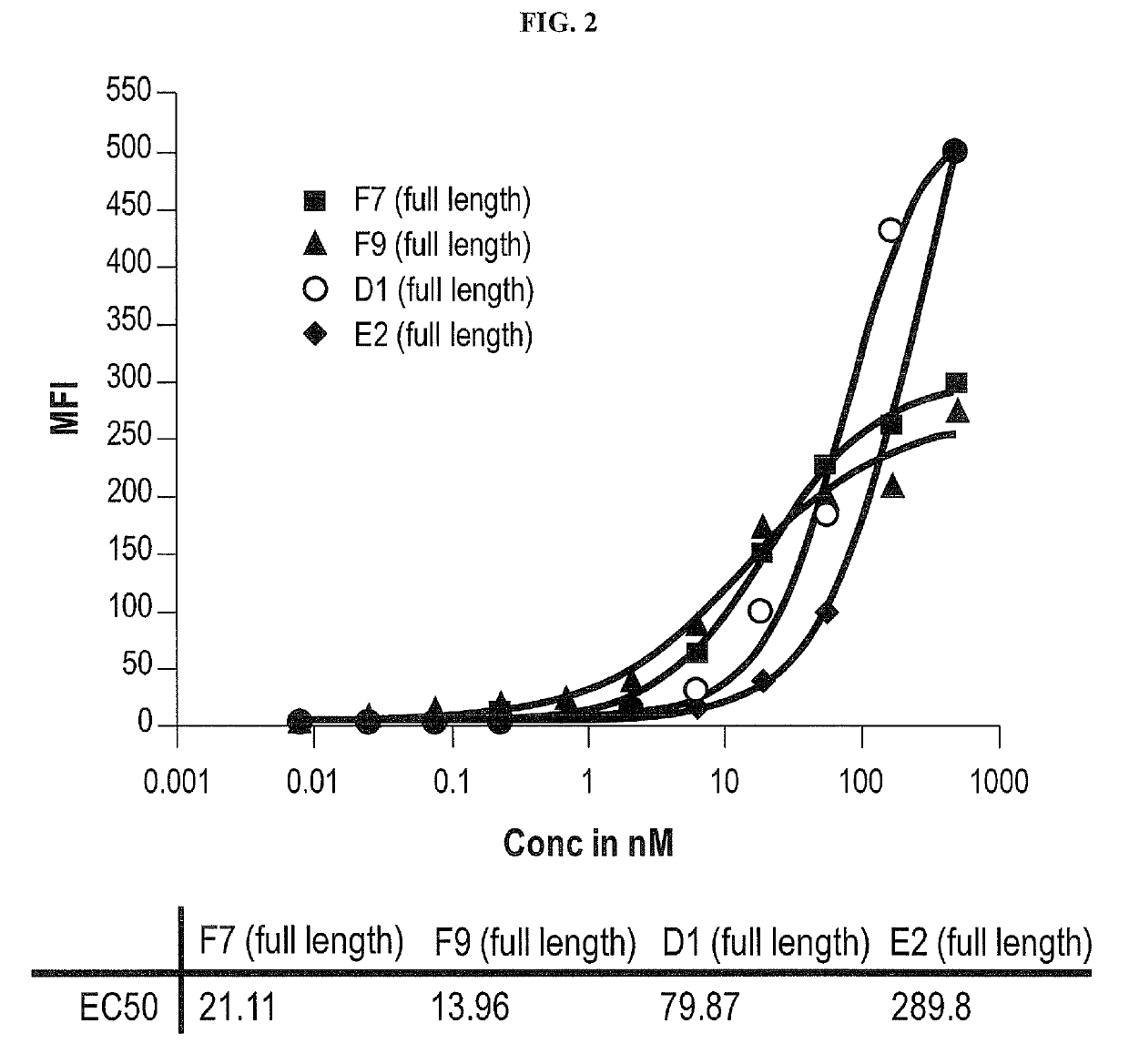Treatment of hematologic malignancies with an anti-CXCR4 antibody
a technology of anticxcr4 and hematologic malignancies, which is applied in the field of human monoclonal antibodies, can solve the problems of skeletal destruction, bm and renal failure, immunodeficiency, and skeletal destruction, and achieve the effect of inhibiting capillary tube formation
- Summary
- Abstract
- Description
- Claims
- Application Information
AI Technical Summary
Benefits of technology
Problems solved by technology
Method used
Image
Examples
example 1
Generation of Human Monoclonal Antibodies Against CXCR4 and CXCL12
[0192]Anti-CXCR4 human monoclonal antibodies were generated using a combination approach in which, first, transgenic transchromosomic mice expressing human antibody genes (Medarex KM MOUSE®, Milpitas, Calif., described in PCT Publication No. WO 02 / 43478 and U.S. Pat. No. 7,041,870) were immunized with human CXCR4-transfected R1610 cells to raise in the mice a repertoire of human immunoglobulins specific for human CXCR4 and then, second, a human antibody library was prepared from spleen cells of the mice and displayed on phage such that the phage were then screened for expression of variable region fragments having affinity for CXCR4 by panning with human CXCR4 incorporated into magnetic proteoliposomes (CXCR4-MPL). Variable region fragments of interest were recloned into a Fab expression vector and the Fab retested for antigen binding against transfected CXCR4-expressing cells. Fab clones F7 (since redesignated MDX-13...
example 2
Structural Characterization of Human Anti-CXCR4 Monoclonal Antibodies F7, F9, D1 and E2
[0195]The cDNA sequences encoding the heavy and light chain variable regions of the F7, F9, D1 and E2 Fab clones, obtained from phage display library screening as described in Example 1, were sequenced using standard DNA sequencing techniques.
[0196]The nucleotide and amino acid sequences of the heavy chain variable region of F7 are shown in FIG. 1A and in SEQ ID NO: 33 and 25, respectively. The nucleotide and amino acid sequences of the light chain variable region of F7 are shown in FIG. 1B and in SEQ ID NO: 37 and 29, respectively.
[0197]Comparison of the F7 heavy chain immunoglobulin sequence to the known human germline immunoglobulin heavy chain sequences demonstrated that the F7 heavy chain utilizes a VH segment from human germline VH 3-48, a D segment from the human germline 4-23, and a JH segment from human germline JH 6B. Further analysis of the F7 VH sequence using the Kabat system of CDR r...
example 3
Binding Characteristics of Anti-CXCR4 Human Monoclonal Antibodies
[0203]In this example, binding characteristics of the anti-CXCR4 antibodies were examined by flow cytometry.
[0204]The human T cell line CEM, which expresses native human CXCR4 on its cell surface, was used to examine the ability of the F7, F9, D1 and E2 antibodies to bind to native, cell-surface CXCR4. Full-length F7, F9, D1 and E2 were titrated in a 1:3 serial dilution series, resulting in a concentration range from 300 nM to 5 pM. The antibodies were then mixed with CEM cells and allowed to bind before being detected with a FITC-conjugated anti-human IgG secondary antibody. The cells were then analyzed by fluorescence cytometry. The resulting mean fluorescence intensities are shown in the graph of FIG. 2, which demonstrates that all four anti-CXCR4 antibodies bind to CEM cells. The EC50 for binding F7, F9, D1 and E2 were 21 nM, 14 nM, 80 nM and 290 nM, respectively.
[0205]To determine the ability of a panel of anti-CX...
PUM
| Property | Measurement | Unit |
|---|---|---|
| concentration | aaaaa | aaaaa |
| concentration | aaaaa | aaaaa |
| volume | aaaaa | aaaaa |
Abstract
Description
Claims
Application Information
 Login to View More
Login to View More - Generate Ideas
- Intellectual Property
- Life Sciences
- Materials
- Tech Scout
- Unparalleled Data Quality
- Higher Quality Content
- 60% Fewer Hallucinations
Browse by: Latest US Patents, China's latest patents, Technical Efficacy Thesaurus, Application Domain, Technology Topic, Popular Technical Reports.
© 2025 PatSnap. All rights reserved.Legal|Privacy policy|Modern Slavery Act Transparency Statement|Sitemap|About US| Contact US: help@patsnap.com



